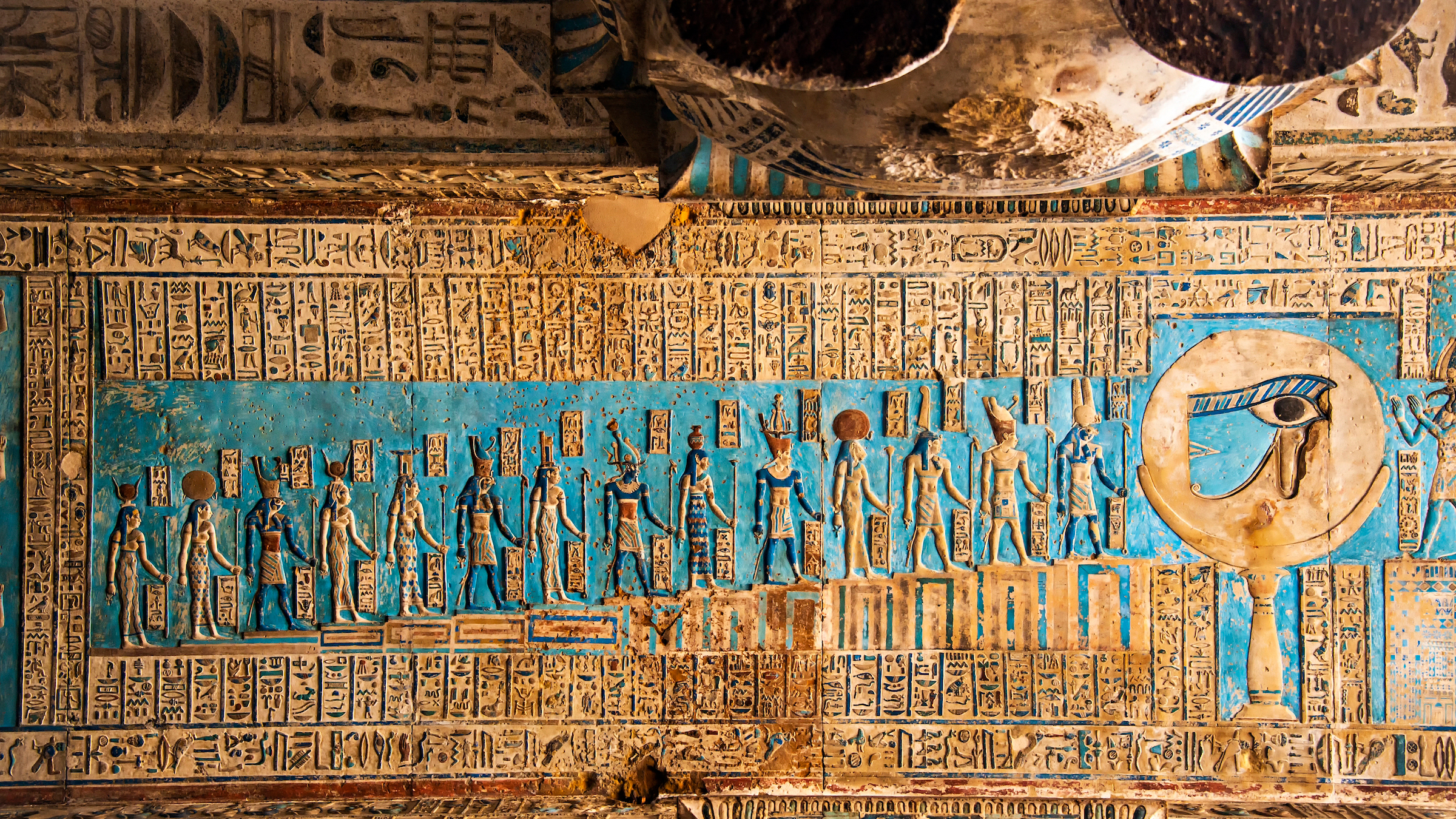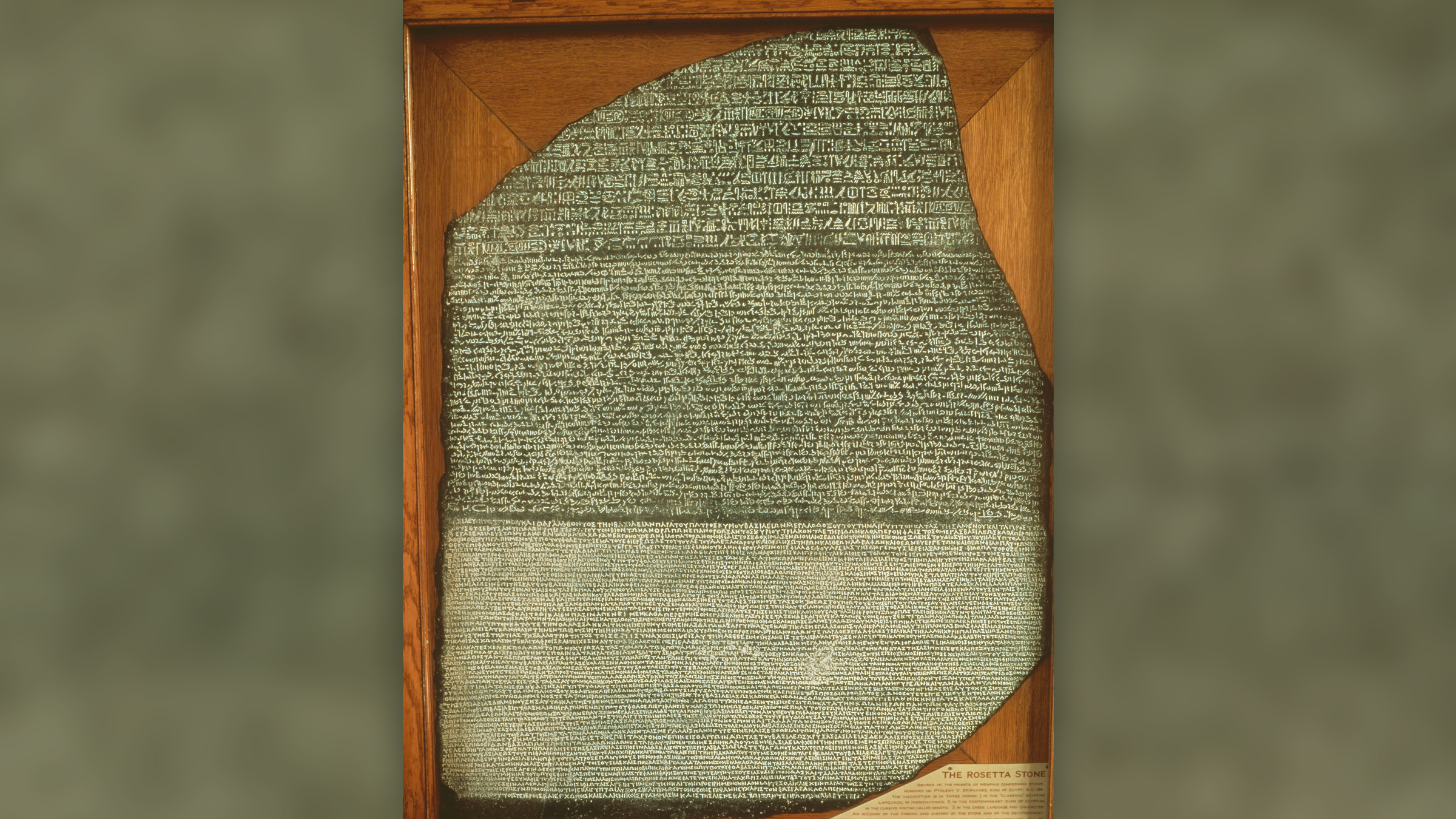How do we decipher Egyptian hieroglyphics and other ancient languages?
It took more than 20 years to translate the Rosetta stone.
Some ancient societies had written languages, but deciphering their texts can be a Sisyphean task. So, how do experts figure out how to translate ancient words into modern ones?
The answer is multifaceted, but one famous example embodies some of the best practices: the decoding of the Rosetta stone, discovered by a French military expedition in Egypt in July 1799, which helped pave the way to the decipherment of Egyptian hieroglyphs.
The stone contains a decree of Ptolemy V that was inscribed in three writing systems: Egyptian hieroglyphics, demotic script (used by the Egyptians between the seventh century B.C. and the fifth century A.D.) and ancient Greek. Written in 196 B.C., the decree stated that Egyptian priests agreed to crown Ptolemy V pharaoh in exchange for tax breaks. At the time, Egypt was governed by a dynasty of rulers descended from Ptolemy I, one of Alexander the Great's Macedonian generals.
Related: What if Alexander the Great left his empire to one person?
At the time the stone was discovered, both hieroglyphics and demotic script were undeciphered, but ancient Greek was known. The fact that the same decree was preserved in three languages meant that scholars could read the Greek portion of the text and compare it with the hieroglyphic and demotic portions to determine what the equivalent parts were.
"The Rosetta inscription has become the icon of decipherment, in general, with the implication that having bilinguals is the single most important key to decipherment. But notice this: although copies of the Rosetta inscription were circulated among scholars ever since its discovery, it would take more than two decades before any significant progress in decipherment was made" Andréas Stauder, an Egyptology professor at École Pratique des Hautes Études in Paris, told Live Science in an email.
Hieroglyphic writing contains signs that represent sounds and other signs that represent ideas (like how nowadays people use a heart sign to represent love) said James Allen, an Egyptology professor at Brown University. Up until the scholar Jean-François Champollion (1790-1832) started studying hieroglyphs, "scholars basically believed that all hieroglyphs were only symbolic" Allen told Live Science in an email, noting that Champollion's most important "contribution was to recognize that they could also represent sounds."
Get the world’s most fascinating discoveries delivered straight to your inbox.
Since Champollion "knew Coptic — the last stage of ancient Egyptian, written in Greek letters — he could figure out the sound value of hieroglyphs from the correspondence between the Egyptian hieroglyphs and the Greek translation on the Rosetta Stone," Allen said.
"Champollion's knowledge of Egyptian Coptic meant that he was able to see the connection between the ancient symbols he was studying and the sounds that he was already familiar with from Coptic words," said Margaret Maitland, principal curator of the Ancient Mediterranean at National Museums Scotland. Maitland pointed out that it was the Egyptian scholar Rufa'il Zakhûr who suggested to Champollion that he learn Coptic.
"Champollion studied Coptic with him and Yuhanna Chiftichi, an Egyptian priest based in Paris. Arab scholars had already recognized the connection between the ancient and later forms of Egyptian language [such as Coptic]," Maitland said.
"Egyptian hieroglyphs could simply not have been deciphered without Coptic," Stauder said.
Three decipherment problems
While Egyptian hieroglyphs were deciphered in the 19th century, there are still a number of ancient languages that are not understood today.
"There are basically three kinds of decipherment problems," Allen told Live Science. Egyptian hieroglyphic writing falls into the category of a case in which "the language is known, but not the script," said Allen. Put another way, scholars already knew the ancient Egyptian language from Coptic, but did not know what the hieroglyphic signs meant.
Related: Is Latin a dead language?
Another decipherment problem is where "the script is known, but not the language," Allen said. "Examples are Etruscan, which uses the Latin alphabet, and Meroitic, which uses a script derived from Egyptian hieroglyphs. In this case, we can read the words, but we don't know what they mean," Allen said. (The Etruscans lived in what is now Italy, and the Meroitics lived in northern Africa.)
The third type of decipherment problem is where "neither the script nor the language are known," Allen said, noting that an example of this is the Indus Valley script from what is now modern-day Pakistan and northern India, as scholars don't know what the script is or what language it represents.
Piecing languages together
There are a number of lessons that scholars working on undeciphered scripts can learn from the decipherment of Egyptian hieroglyphs.
"One of the main theses of our book is that it's generally better to consider an ancient script in its cultural context," said Diane Josefowicz, a writer who holds a doctorate in science history and co-authored the recently published book "The Riddle of the Rosetta: How an English Polymath and a French Polyglot Discovered the Meaning of Egyptian Hieroglyphs" (Princeton University Press, 2020). Josefowicz noted that Thomas Young (1773-1829), a British scientist who also tried to decipher Egyptian hieroglyphs, "approached the decipherment like a crossword puzzle because he didn't really care about ancient Egypt," Josefowicz told Live Science in an email.
"Champollion was much more interested in Egyptian history and culture, and because of this he was one of the first to make extensive use of Coptic, a late form of ancient Egyptian, in his study of hieroglyphics," Josefowicz said.
Being able to relate an undeciphered script to a language or language group is vital, Stauder added. Champollion needed to know Coptic in order to understand Egyptian hieroglyphs, said Stauder, who noted that scholars who deciphered ancient Mayan glyphs used their knowledge of modern Mayan languages while deciphering the glyphs.
Stauder noted that scholars who are trying to decipher Meroitic are making more progress because they now know that it is related to the North-East Sudanese language family. "The further decipherment of Meroitic is now greatly helped by comparison with other languages from the North-East Sudanese and the reconstruction of substantial parts of the lexicon of proto-North-East-Sudanese based on the currently spoken languages of that family" Stauder said.
Maitland agreed, saying, "languages that still survive but are currently under threat could prove crucial to progress with still undeciphered ancient scripts."
Originally published on Live Science.

Owen Jarus is a regular contributor to Live Science who writes about archaeology and humans' past. He has also written for The Independent (UK), The Canadian Press (CP) and The Associated Press (AP), among others. Owen has a bachelor of arts degree from the University of Toronto and a journalism degree from Ryerson University.





